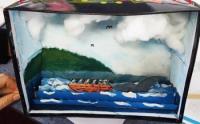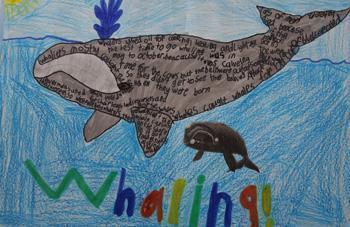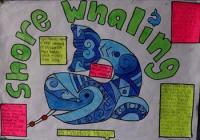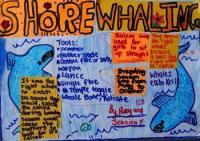Whaling
Whalers killed the Southern Right whale because it was the right whale to catch. It was dirty, smelly and dangerous work.
The whaling season was from May to October. The whalers caught this particular type of whale for its blubber and baleen. The thick blubber meant the whale floated when it was killed, which made their job easier. They boiled the blubber in big pots called trypots to get oil, which they used for cooking, lighting and heating. They used the baleen for buggy whips, chair seats and ladies corsets. Whalers mainly killed the mothers (cows) and the babies (calves) as they were more often than not swimming together. The bulls (males) were harder and bigger to catch. Whaling was dangerous because the whale could lift it's tail and crash it down on the boat.
First the whale is caught by the harpoon, which is a type of spear. Then it is towed from the sea to the shore. As it is thick with blubber it can float really easily. The whalers then strip off the blubber and put it in the trypot. The remains were left to rot on the beach.
Whales are being killed all over the the world, day and night, although today most countries are against whaling. Around 16,000 whales have been killed each year over 83 consecutive years. Since 1986, over 25,000 whales have been killed legally for scientific research.
“Thar she blows”
“To the ships”
In 1830s whaling started. Some whalers lost their hands from when they harpooned the whale. The rope was in a coil so if a whaler's hand got stuck in a coil it was bad luck for them and goodbye hand.
Some lost their life because the whale got angry and would hit boat with its tail. If you were underneath it's tail you would have died. You may have survived this but you would still die if you were capsized out of your boat and weren't able to swim.
Whalers caught the right whale because it was slow moving, had thick blubber and didn't dive too deep. If you were a whaler you would need to know if it was a Southern Right whale or another whale like a Sperm whale. The Southern Right whale’s spout is a v shape. This is a good way to tell the difference.
I am glad that whaling is not still happening in Porirua.
"Thar she spouts boys. Thar she blows," cried the lookout. A whale has been spotted out by Mana Island, within minutes the crew's men have rowed off. As soon as they are close enough the headsman throws the spear into the whale, digging into its skin. The whale lets out an ear piercing shriek. The whale takes off at tremendous speeds, dipping and diving trying to get away. Finally after one whole hour the whale is too tired to move. The headsman makes the final blow, killing the whale. Blood fills the water turning it as red as a poppy. Whaling is a cruel and dangerous job.
Shore whaling
Shore whaling started in the 1830s and lasted for many years. Shore whaling was from May to October because it was during the right whale's breeding season. This made the whales slow down which meant it was easier for the whalers to catch them. The whalers went out to sea on their boats to kill the whales and then towed them back to Paremata, Te Korohiwa and Mana Island whaling stations. They killed the whales with harpoons attached to ropes. When the rope went out fast some of the whalers lost their hands. The Pakeha started whaling and Joseph Toms was one of the well known whalers. A few years later Māori carried it on for 20 years. They captured the Southern Right whales for their blubber and baleen so they could trade for muskets and blankets.
Joseph Toms
From the early years of the nineteenth century Europeans, mainly whalers, sealers and traders visited Paremata Point. In 1835 Joseph Toms, also known as Geordie Bolts (a whaler from the Sydney suburb of Parramatta) married Te Ua Torikiriki, a demanding whaler in her own right and daughter of Nohorua, a chief.
Toms established his whaling station at Paremata Point. With a mixture of Pakeha and Ngāti Toa whalers. He used up to seven six-oared row boats to chase the slow right whales that migrated through the Cook Strait and past Porirua every year.
By Holly, Haylee, Will, Chloe, Emilee, Aimee, Milla, Bee, Campbell, Lillian, Claudia, Meillyn, Jessica Y, Ekodi, Breanna, Ruby B, Ruby D, Ella and Thomina.









